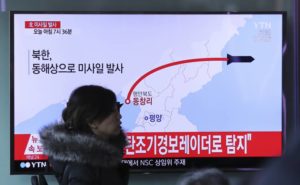by WorldTribune Staff, March 6, 2017
Japan moved to its highest possible military alert level on March 6 after three North Korean missiles landed in the Sea of Japan.
In the latest provocation from the Kim Jong-Un regime, three of four missiles fired by Pyongyang landed in Tokyo’s exclusive economic zone (EEZ), with one falling 350 kilometers (217 miles) west of Japan’s northern Akita prefecture, government spokesman Yoshihide Suga told reporters after a meeting of Japan’s National Security Council (NSC).

Officials said the North fired the barrage of missiles at around 7:34 a.m. Japan time from near North Korea’s Donchang-ri long-range missile site.
Russia said it is concerned about North Korea’s latest missile drills, Kremlin spokesman Dmitry Peskov said on March 6.
“Definitely, we are seriously worried — these are the sort of actions that lead to a rise in tension in the region and of course in this situation, traditionally, Moscow calls for restraint from all sides,” Peskov said during a conference call with reporters.
During the March 6 Upper House Budget Committee session, Japanese Prime Minister Shinzo Abe condemned the provocation as “utterly intolerable” and noted the North’s accelerating technological advancements.
“(The test-firing) clearly shows that North Korea is now a new level of threat,” Abe said.
The prime minister also said that “Japan will continue to coordinate closely with the United States, South Korea and other countries to strongly urge North Korea to exercise restraint.”
Suga said the Tokyo government had already lodged protests with Pyongyang — using the “strongest terms” — through the embassy in Beijing.
Last month, the North defiantly test-fired a new type of medium-range missile that is believed to use solid fuel. The launch came during Abe’s first summit talks with U.S. President Donald Trump.
Analysts said the March 6 missile salvo appeared to be similar to ones conducted last year.
“Although we cannot be 100 percent certain what type of missiles were fired until we get images from KCNA, the range and apogee would indicate they are closer to an extended range Scud or Rodong missile used in a salvo launch,” said David Schmerler, a researcher at the Center for Nonproliferation Studies at the Middlebury Institute of International Studies. “We saw launches like this last year off of Reunification Highway near Hwangju.”
The timing of the March 6 launches are particularly sensitive as tensions have escalated in recent weeks between China and South Korea over American plans to deploy the THAAD missile-defense system on the peninsula, part of measures to stop North Korea from gaining the ability to strike the continental U.S. with a nuclear warhead.
“The launches also come as South Korea and the U.S. undertake annual military drills that Pyongyang has called a prelude to an invasion, and right after the start of the National People’s Congress in Beijing – a gathering aimed at showcasing President Xi Jinping’s command over foreign and domestic affairs,” Bloomberg reported.
